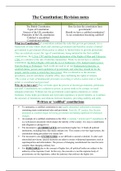The Constitution: Revision notes
Key concepts Content and arguments
The British Constitution How far does the constitution limit
Types of Constitution government?
Sources of the UK constitution Should we have a codified constitution?
Principles of the UK constitution Is our constitution becoming codified?
Codified vs uncodified
Constitutional reforms
What is a Constitution? A constitution contains the rules that govern government; it is a
framework of rules which check and constrain government and therefore creates a limited
government (a government whose power is subject to limited status to provide protection).
They are relatively recent, the ‘age of constitutions; being initiated by the first codified
constitutions, the U.S in 1787 and the French declaration of the Rights of Man and Citizen in
1789, as a solution to the rule of absolute monarchies. While we do not have a codified
constitution, the Bill of Rights 1689 and the Act of Settlement 1701, helped transfer power
from the King to Parliament. Such words are used to set out fundamental principles, to
establish duties, powers and regulations of government, and what they should do for the
people, and the extent to which they have power. This is referred to as the structure,
procedures, powers and duties of public office, also confirming the rights of citizens.
‘The system or body of fundamental principles according to which a nation state or body
politic is constituted and governed.’
Why do we have one? They set limits upon the powers of elected governments, politicians
and staff. Constitutions are a solution to power, as power tends to be corrupt, we need
adequate protection. Without one, the government could oppress minorities or violate
freedoms. It also helps government and it provides legitimacy to power holders, as it outlines
the structure of institutions and relations between branches, providing stability and order.
Written or ‘codified’ constitutions
To summarise, a codified constitution is one legally entrenched, authoritative document,
containing main constitutional rules and provisions. From the 18th century, they become
prominent as countries began reviewing government and making significant revolutionary
changes.
An example of a codified constitution is the USA; it contains 7 articles and 27 amendments. It
is a well-known document which shapes the identity of the country. It is easy to understand,
and allegiance is pledged to it.
The document is AUTHORITATIVE and constitutes higher law. It binds all political
institutions, including those that made ordinary law. This creates a two-tier legal system, the
constitution taking precedent over statute law.
The document is also ENTRENCHED, so are difficult to amend or abolish. To alter such
entrenched provisions, special measures are taken to ensure widespread agreement, such as
supermajorities and referendums. The process of changing constitutional law must be more
complex than changing ordinary law.
It is JUDICIABLE due to the concept of higher law; all political bodies are subject to the
authority of the Supreme Court. In this way, the executive is not the supreme body of
government, nor the legislature, rather the judiciary that enforces the higher law.




